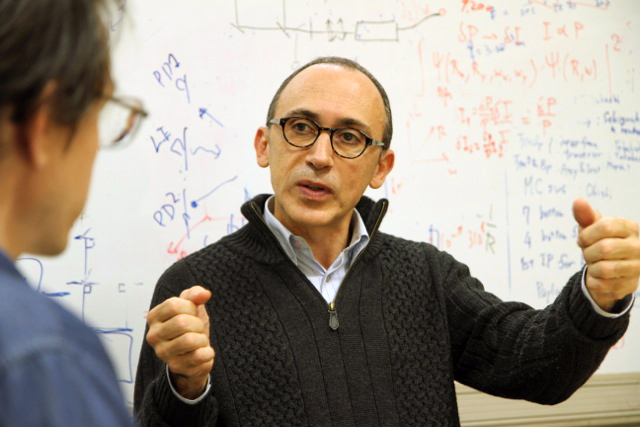重力波プロジェクト推進室長 ラファエレ・フラミニオ博士 インタビュー [3/4]

――どのような現象から重力波が発生するのでしょうか?
What kinds of phenomena produce gravitational waves?
Flaminio:いろいろな種類の現象がありますが、一番面白いのは、とても小さくてとても重い天体からなる連星系です。中性子星やブラックホールのような小さくて中身がぎっしり詰まった星が、お互いの周りをまわりながらゆっくりと近づいていき、速度がだんだん速くなっていって、最後には合体してふつうは一つのブラックホールになります。これは本当に興味深い現象で、割と頻繁に起きていると思われています。今ある干渉計で、ひと月に1度くらいの頻度で、こういった現象を観測することができるでしょう。
There are many different kinds of phenomena. One of the most interesting is these binary systems of compact objects like neutron stars or black holes rotating around each other, which slowly get closer and closer; rotating more and more rapidly until the moment that they actually merge into a single object, which usually should be a black hole. This is a very interesting phenomenon that we expect to happen relatively often; with the coming interferometers, we expect to be able to see events of this kind like once a month.
このような現象から、いろいろなことがわかるようになります。中性子星の場合は、星の内部の構造を詳しく調べることができます。想像してみてください。二つの星が徐々に近づいていくと、星の形が変わっていきます。星の形がどのように変わるかは、星の内部がどうなっているかによって変わってきます。ですから、星の状態方程式について調べることができるわけです。ブラックホールの場合は、重力がブラックホールの近くでどのように振る舞うのかを知ることができます。どちらの場合でも、二つの星が合体してからどのようにブラックホールが作られるのかを見ることができます。実際は振動すると思われていますが。このように、他のどのような方法でも実現することのできない条件の下、とても良い精度で一般相対性理論を検証することができるのです。
This kind of event can give us a lot of information. For the case of neutron stars, we can learn the details of the internal structure of the stars. You can imagine that as these two stars get closer and closer they deform, and the way they deform depends on their internal structures. So you can get information about the actual equation of state of the star. And in the case of black holes you can get information about how gravity behaves near the black holes. In both cases you can see how the black hole, formed after the two stars coalesce, actually vibrates. So you can get very precise tests of the Theory of General Relativity in conditions that we cannot have by any other means.
あるいはこんなふうに言ってみてもいいでしょう。私たちは最初から重力を知っていた。それなのに、私たちは重力という力についてあまりにも知らなさすぎる。電磁気力、弱い力、核力といった他の力と比べるとその差は明らかです。重力を規定する数字は、他の力と比べると粗くしか分かっていません。重力波をつかって、ブラックホールや中性子星の周りで起こっていることを調べることができれば、重力という力についてより多くを知ることができるでしょう。そして一般相対性理論がこのような場合に実際にどう働くのかも分かるでしょう。
It is interesting to note that despite the fact that we have known about gravity since the beginning, our knowledge of the gravitational force is relatively poor compared to other forces like the electo-magnetic force, or weak forces, or nuclear forces. The precision which we have on the parameter that governs gravity is relatively low. By using gravitational waves as a probe to study what happens around a black hole, or what happens near neutron stars, we can learn a lot more about the gravitational force, about how General Relativity really works in those conditions.
連星合体は、おそらく最も面白い重力波源ですが、他にも、高速で回転する中性子星のようなものもあります。私たちの住む銀河には、何十億という中性子星があって、それぞれがその回転周波数で重力波を放っているでしょう。
These are probably one of the most interesting phenomena, but there are other phenomena like rapidly rotating neutron stars. We know there are like billions of neutron stars in our galaxy. And they should emit gravitational waves at their rotation frequencies.
さらに、大爆発によって重力波が発生します。星がその一生の最期に起こす、超新星爆発と呼ばれる大爆発。そして、もっとも重要な爆発は、なんといっても宇宙が誕生した時の大爆発、ビッグバンです。宇宙の誕生からはるかな時を経た今もなお、ビッグバンから放たれた重力波を、私たちは見ることができるかもしれません。
Other phenomena are big explosions, like the explosion of a star at the end of its life, a so-called super nova. And of course the most important explosion, the Big Bang itself, at the birth of the Universe should have produced gravitational waves that we might be able to see, even now days.
――どれくらい遠くまで、連星合体などの現象を捉えることができるのでしょう。
How far away do you expect to be able to detect these phenomena?
Flaminio:AdvLIGOやAdvVIRGOといった新しい重力波望遠鏡では、およそ10億光年先で起こる中性子星連星の合体も見ることができるはずです。この距離は中性子星の場合で、ブラックホールの場合は、その質量によってちがいますが、だいたい中性子星の10倍遠くまで見ることができるでしょう。そしてこの観測可能な領域の中には、数百万もの銀河が存在します。これら全ての銀河を観測することで、私たちは月に1回くらい連星合体を捉えることができるだろうと思っています。
These new detectors should be able to see the coalescence of binary neutron stars up to distances of the order of nearly 1 billion light-years. This is for neutron stars, for the case of black holes, it depends on the masses of the black holes, but typically you can see a distance 10 times farther. And there are millions of galaxies in this volume. By monitoring all of these galaxies, we hope to see about 1 event per month.

